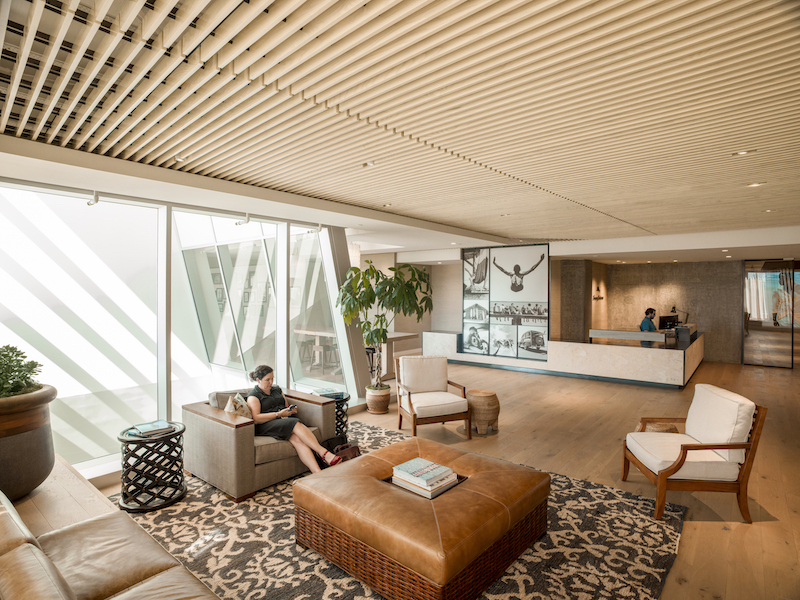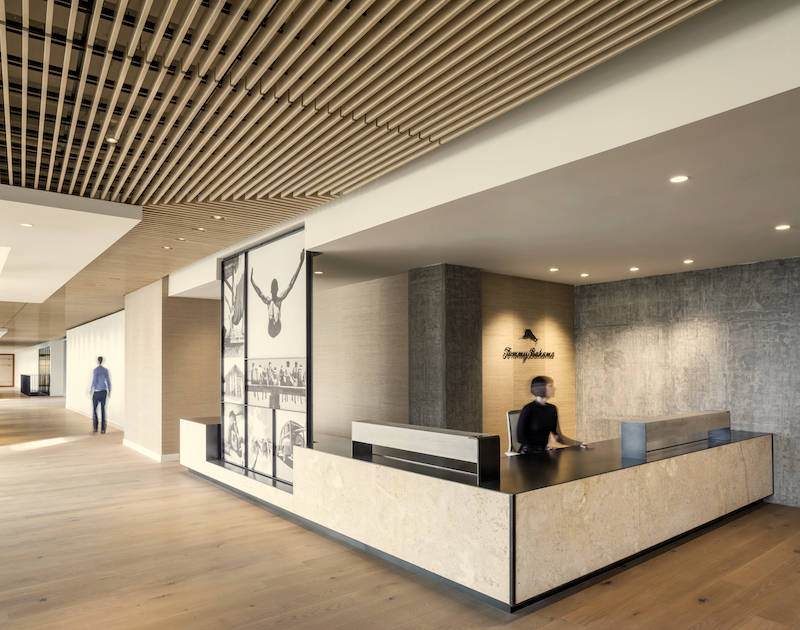Tommy Bahama’s new 120,000-sf Seattle campus has a design focused on user experience and was inspired by the company’s ethos to “Make Life One Long Weekend.”
The open, casual setting has spaces that feature a natural material palette and rich textures such as woven fabric wall coverings and rough-honed stone. A “grand boardwalk” organizes the space and draws guests from the main lobby and reception to the showroom, mock store, and collaborative workspaces. Casual seating areas line the boardwalk and provide opportunities for informal gatherings.
 Photo: Magda Biernat.
Photo: Magda Biernat.
Workspaces have been designed with flexibility in mind so users can tailor the environment based on departmental and team requirements. The reception area and amenities are located on an intermediate level of the HQ’s four floors to ensure employee interaction and social engagement.
The company decided to lease the floors for the headquarters space in the base of the office tower as opposed to the upper floors in order to create and reinforce physical and visual connections to the community. Breakout and workspaces were designed around large four-story light monitors with access to the market hall at the base of the building to encourage gathering.
 Photo: Spencer Lowell.
Photo: Spencer Lowell.
Each floor has its own coffee bar and a 1,000-sf café on the main level opens out to a 1,500-sf roof deck. The office’s customized workstations feature sit-to-stand desks, ergonomic monitor arms, and task lighting.
The building team includes SkB Architects (interior architecture and interior design), MKA (structural), Lima (lighting), GCH (landscape), Stantec (acoustical), Commercial Office Interiors (furniture procurement), University Mechanical (mechanical-plumbing design-build), Veca (electrical design-build), Skanska (contractor).
 Photo: Magda Biernat.
Photo: Magda Biernat.
 Photo: Magda Biernat.
Photo: Magda Biernat.
Related Stories
| Jan 9, 2015
Technology and media tenants, not financial companies, fill up One World Trade Center
The financial sector has almost no presence in the new tower, with creative and media companies, such as magazine publisher Conde Nast, dominating the vast majority of leased space.
| Jan 8, 2015
The future of alternative work spaces: open-access markets, co-working, and in-between spaces
During the past five years, people have begun to actively seek out third places not just to get a day’s work done, but to develop businesses of a new kind and establish themselves as part of a real-time conversation of diverse entrepreneurs, writes Gensler's Shawn Gehle.
Smart Buildings | Jan 7, 2015
Best practices for urban infill development: Embrace the region's character, master the pedestrian experience
If an urban building isn’t grounded in the local region’s character, it will end up feeling generic and out-of-place. To do urban infill the right way, it’s essential to slow down and pay proper attention to the context of an urban environment, writes GS&P's Joe Bucher.
| Jan 6, 2015
Construction permits exceeded $2 billion in Minneapolis in 2014
Two major projects—a new stadium for the Minnesota Vikings NFL team and the city’s Downtown East redevelopment—accounted for about half of the total worth of the permits issued.
| Jan 2, 2015
Construction put in place enjoyed healthy gains in 2014
Construction consultant FMI foresees—with some caveats—continuing growth in the office, lodging, and manufacturing sectors. But funding uncertainties raise red flags in education and healthcare.
| Dec 28, 2014
Robots, drones, and printed buildings: The promise of automated construction
Building Teams across the globe are employing advanced robotics to simplify what is inherently a complex, messy process—construction.
| Dec 28, 2014
AIA course: Enhancing interior comfort while improving overall building efficacy
Providing more comfortable conditions to building occupants has become a top priority in today’s interior designs. This course is worth 1.0 AIA LU/HSW.
| Dec 28, 2014
10 key design interventions for a healthier, happier, and more productive workplace
Numerous studies and mountains of evidence confirm what common sense has long suggested: healthy, happier workers are more productive, more likely to collaborate with colleagues, and more likely to innovate in ways that benefit the bottom line, writes Gensler's Kirsten Ritchie.
| Dec 28, 2014
Workplace design trends: Make way for the Millennials
Driven by changing work styles, mobile technology, and the growing presence of Millennials, today’s workplaces are changing, mostly for the better. We examine the top office design trends.
| Dec 27, 2014
7 ways to enhance workplace mobility
The open work environment has allowed owners to house more employees in smaller spaces, minimizing the required real estate and capital costs. But, what about all of their wireless devices?















